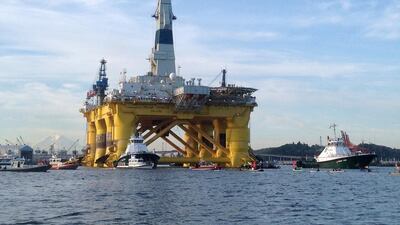Shell announced this week that it was abandoning efforts to develop oil from the Alaska’s outer continental shelf (OCS).
The company had drilled a well in the Burger prospect in the Chukchi Sea this past summer, but the results were disappointing. Although the company found hydrocarbons, the flows were insufficient to warrant further exploration. With that, Shell decided to suspend activities in Alaskan waters indefinitely.
Shell had such high hopes. If all went well, it would have produced an average of 650,000 barrels of oil for 35 years from the OCS. From 2025 until 2060, the OCS would power Alaska’s economy and contribute up to 10 per cent of domestic US oil production.
The project, which we estimated would cost more than US$300 billion in total, would have represented the largest infrastructure project in the United States in the next 15 years.
There was no more visionary initiative anywhere in the world.
For Shell, the Alaskan OCS was the third leg in the company’s answer to peak oil. Shell was among the first to recognise in 2005 that increasing oil production would be a heroic undertaking. Finding new oil would be “no cheaper, no easier”, it said.
To meet the challenge, Shell proposed a three-legged strategy. First, a massive gas-to-liquids plant would be constructed in Qatar. And it was. The Pearl GTL plant, as it is called today, came on line in 2011. It produces 8 per cent of Shell’s total output, equalling 260,000 barrels of diesel and lubricants daily.
The second leg of Shell’s strategy rested on a series of liquefied natural gas plants. These plans were essentially scrapped earlier this year when Shell cancelled four LNG projects.
This left the third leg, Alaska, which was perhaps the jewel in the crown. The scale of ambition, the volumes, the duration and the vision were breathtaking. The commitment was enduring. Even when the going got tough, Shell hung in there and continued to fight for Alaska, despite headwinds from regulators, Greenpeace and a series of technical setbacks.
With weak initial well results, however, Shell capitulated and has suspended operations in Alaska “for the foreseeable future”, which should be read as “permanently”.
The vision of oil scarcity that fuelled Shell’s ambitions after 2005 has dissolved, the victim of the shale revolution. As little as two years ago, the promise of shale was uncertain and underestimated (not least by me).
Whereas Shell was prepared to go to the ends of the earth for new oil, company management could have driven a couple of hours from corporate headquarters to a fully plumbed basin – the Permian – and produced more oil with nothing more than fracking and horizontal drilling.
Alaska is redundant under such circumstances. Consequently, until the shale revolution has run its course and oil prices have returned closer to $100 per barrel, expect Shell to keep its distance from Alaska. By the time the dust has settled, the wait could be a decade or more.
And yet I still believe in Shell’s earlier vision. Shale may prove an endless cornucopia of new oil, but maybe not. The oil and gas division of North Dakota’s Department of Mineral Resources has estimated that Bakken shale oil production would only be 35,000 barrels per day higher at the end of 2017 than it is today, even at Brent oil prices above $95 per barrel. Restarting US shale may take much higher prices and much more time than anticipated.
The flood might not last. No one expects shale growth to last past 2025, and many see a peak before 2020. Shell, by contrast, would not have begun flowing oil from Alaska until after 2025.
If we look in decadal terms rather than quarterly, Shell’s visionaries may ultimately be vindicated. Shale, to the best of our knowledge, will not cover us for more than a few more years. In all likelihood, we will need the oil for which Shell is searching in Alaska.
Nor has Shell entirely closed the door. Marvin Odum, Shell’s director of upstream Americas business, has said that Shell “continues to see important exploration potential in [offshore Alaska], and the area is likely to ultimately be of strategic importance to Alaska and the US.”
With oil prices at current levels, however, even three months has become a long time for a company such as Shell. Why was its decision to abandon Alaska announced two days before the end of the quarter? One might speculate that third-quarter financial results would be so disastrous that Shell would want to be able to demonstrate tangible, direct and immediate commitment to reducing expenses and capital expenditures. There is no easier place to cut than Alaska.
Even if everything went well, Shell would not see a dime from Alaska for at least a decade. Terminating Alaska improves the bottom line immediately.
But at what cost? We have allowed the surplus of shale oil to lull us into a false sense of security, that oil has become “cheaper and easier”. And in the short run, it has. But the long run is far from decided.
For now, oil in Alaska is dead. It is dead in Norway and Russia as well. Norway’s Statoil is struggling with costs on its Arctic Johan Castberg project, and Rosneft has conceded that it cannot proceed in Russia’s Kara Sea without its partner ExxonMobil.
Arctic oil, until the shale revolution ends, is in a deep freeze. But this does not mean that we will not need that oil, nor that current oil prices are sustainable.
Rather, the economics of the oil business have become so dire that even the most committed and visionary of companies are forced to abandon their most cherished plans.
Steven Kopits is the managing director of Princeton Energy Advisors in New Jersey

